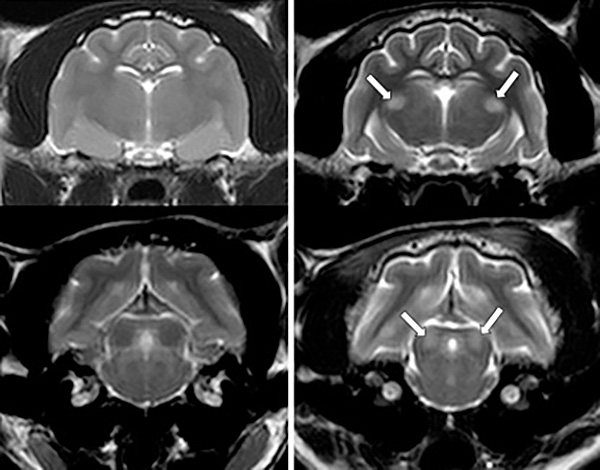RVC clinicians identify source of recent spate of thiamine-deficiency cats
Thiamine deficiency is usually rare and can be life-threatening if not recognised. The RVC has recently diagnosed an increasing number of cats with clinical thiamine deficiency, suspected to be a result of exposure to a thiamine-deficient commercial dry cat food.
The diagnosis of this condition in three cats was confirmed based on a combination of typical clinical signs associated with this condition, classic changes in the brain documented on MRI scans and rapid clinical response to thiamine administration. Our investigation found a common denominator in that each cat was being fed the same commercial cat food.
We contacted the producer of the cat food (Pets at Home), and investigations by the company have confirmed deficient levels of thiamine in four products within their AVA range. As a result the company initiated a voluntary food recall that was announced on Feb 28, 2017 - Voluntary Recall of Indoor, Senior, Mature AVA Dry Cat Food Varieties.
Early recognition of this condition is important and we would advise anyone who is concerned about their cat being affected to seek veterinary attention. All three cats treated at our hospital survived, but one patient has persistent neurological abnormalities six months after initial diagnosis..
Early recognition is important and we would advise to ask your vet if you have any suspicion. All three cats treated at our hospital survived, but one patient has persistent neurological abnormalities six months after initial diagnosis that will likely be permanent as a result of the structural damage to the brain caused by thiamine deficiency.
Thiamine (Vitamin B1) is essential in many metabolic processes in the body. Cats require high levels of thiamine in their diets daily to ensure normal body function. The neurological signs associated with thiamine deficiency in cats can appear within 30-40 days after transitioning to a thiamine-deficient diet, and the clinical course tends to be sudden and rapidly progressive. Typical clinical signs include problems with balance (leaning and falling towards both sides, head tilt), mental depression progressing to coma, difficulty keeping the head held upright, seizures/fitting, pupil dilation, problems with vision and head tremors. If left untreated, thiamine deficiency can be fatal. Before exhibiting the typical neurological signs described above, cats may initially present with decreased appetite, nausea and vomiting, which can further contribute to the thiamine deficiency due to reduced food intake.
Diagnosis of thiamine deficiency is based on a combination of the characteristic clinical signs described above, specific changes in the brain seen on MRI scans, rapid clinical improvement once thiamine supplementation has been administered, documented exposure to a thiamine-deficient diet.

Treatment of suspected thiamine deficiency involves thiamine injections followed by transition to oral thiamine once stable for another month along with feeding a complete and balanced diet. When cases of thiamine deficiency are recognised and treated during the early stages of disease, a full and rapid clinical recovery is possible. However, some cats may end up with permanent neurologic deficits, and so rapid recognition of the condition can help improve the chances of a full recovery.

